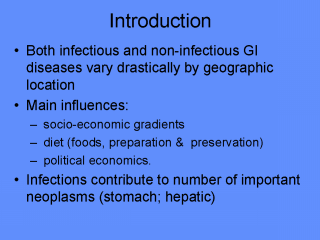| front |1 |2 |3 |4 |5 |6 |7 |8 |9 |10 |11 |12 |13 |14 |15 |16 |17 |18 |19 |20 |21 |review |
 |
There
is tremendous variation in the prevalence and type of GIDs worldwide and some explanation
for this is needed. This variation is seen for both infectious and non-infectious GIDs.
There are a number of clear correlates of variation in GIDs. These can be classified under
three main headings: 1. Socio-economic - largely related to variations in wealth. For example, in under-developed nations chronic under-nutrition and, in extreme cases famine, not only make whole communities less able to resist common infections, they may result in frank starvation. However, even during famine, it is seldom the wealthier people in urban areas who die. Usually, it is the rural poor who are most at risk. In developed or post-industrial nations, inadequate or poor nutrition such as diets low in fresh fruits, vegetables and often high in fat content may result in increased vulnerability to coronary heart disease, cancer and type 2 diabetes mellitus. In addition, viral or bacteria contamination may be more likely. 2. Dietary, deriving partly from 1. above but also being culturally determined. Most cultures have foodstuffs which are known to be hazardous. Often, these traditional foods are preserved, such as the salted dried fish popular in Southern China & Hong Kong, the hot salty tea of the Kashmir Valley in Northern India, quat and betel nut, mild narcotic "digestifs" taken in the Middle East and Indian sub-continent, all of which have been linked to increased risk of GI tumours, such as those of the oesophagus. "Modern" fast food diets are increasingly being targeted as increasing risk for colon cancer. 3. Political-economic factors, often involving industrial or particular political considerations, such as war and civil disorder. War disrupts food supplies, troops destroy or steal crops, leaving communities without food. Less dramatic, but more widespread, intensive commercial pressure promotes less nutritious, expensive processed foods that acquire high status, at the expense of cheap or free local alternatives. An example is the use of baby milk formula instead of breast feeding. While GIDs may be classified into infectious and non-infectious, there is good reason to suspect that many GI tract malignancies involve infectious agents. |
| front |1 |2 |3 |4 |5 |6 |7 |8 |9 |10 |11 |12 |13 |14 |15 |16 |17 |18 |19 |20 |21 |review |